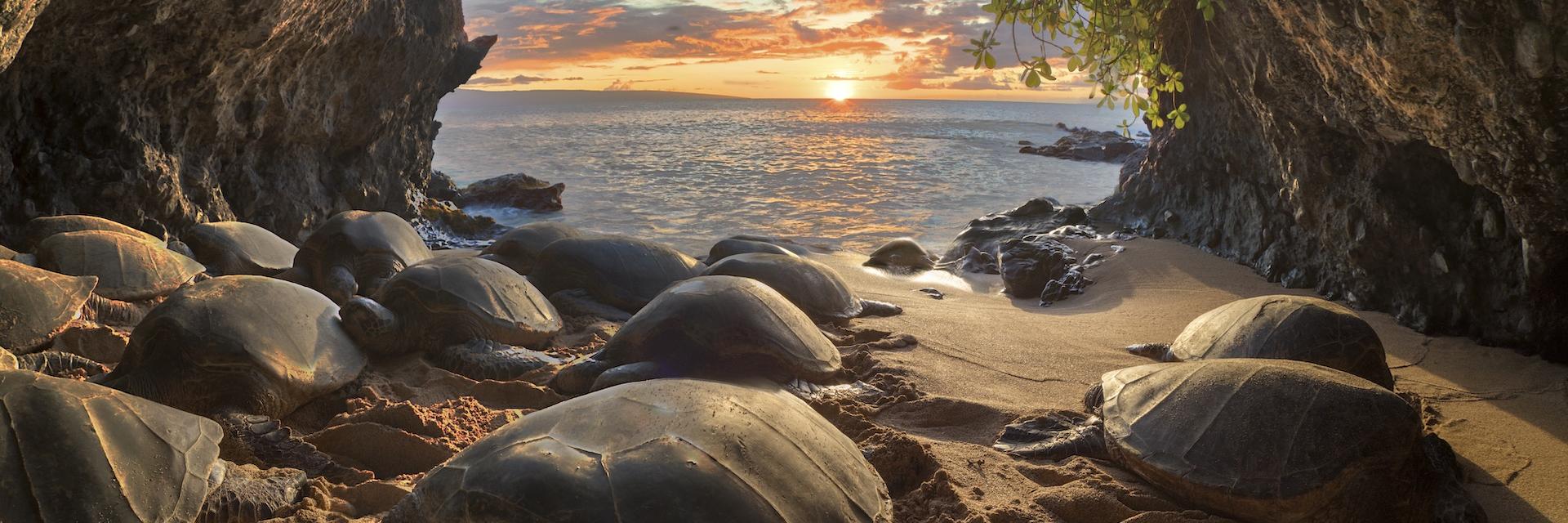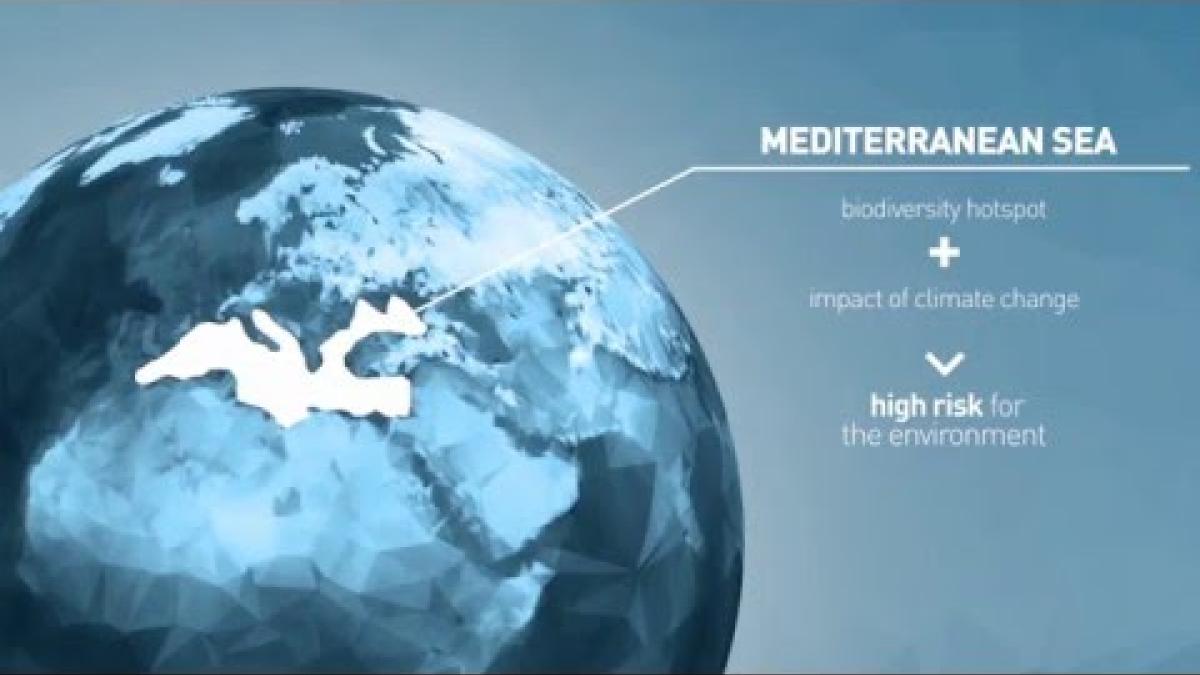
Hawaiian green sea turtles (Chelonia mydas) crowding into a small seaside cavern to bask at sunset. Resting on shore is a behaviour that is very rare for sea turtles, except in Hawaii and the Galapagos Islands. Hawaii, USA.
Credit: Doug Perrine / Minden PicturesMarine Protected Areas
Protect and maintain critical marine environments in oceans, seas, and estuaries to safeguard biodiversity, ecosystems services, and natural and cultural resources.
Marine ecosystems are among the most endangered on the planet. Damage from human activity includes pollution, overfishing, offshore drilling, and seabed mining. Their combination with ocean acidification, warming temperatures, and other effects of climate change has put many marine environments in significant peril. In order to prevent further harm, governments across the globe have been designating Marine Protected Areas (MPAs), which are defined as marine and coastal zones where human activities are restricted and regulated. MPAs protect marine fauna, flora, and ecosystems while providing for Indigenous, traditional, and sustainable economic activities such as responsible fishing and ecotourism. The outcomes of MPAs can be extraordinary. Some have seen a doubling in marine populations, helping fisheries outside their boundaries remain sustainable. Supporting conservation efforts within MPAs and advocating for new and expanded MPAs can help restore the health of our oceans and the local communities that depend on them.
Action Items
Individuals
Learn why MPAs are crucial for ocean conservation. Oceans account for 70 percent of the Earth’s surface, with 27 percent being territorial waters and 43 percent being international waters. Oceans, seas, bays, and estuaries play a critical role in the health of our planet. Over three billion people, millions of livelihoods, and countless aquatic species depend on healthy marine environments. Key points:
- Oceans are a critical sink for atmospheric carbon dioxide, absorbing as much as 30 percent of carbon dioxide emissions released into the air.
- Oceans are home to millions of Earth’s plants and species, from small single-celled organisms to the gigantic blue whale, the world's largest living animal.
- Vast areas of open ocean are beyond the national jurisdiction of countries are among the least protected areas on the planet.
- Overfishing and illegal, unreported, and unregulated (IUU) fishing present the biggest threats to ocean biodiversity. IUU is considered to be the sixth-largest global crime, accounting for up to one in every five fish caught at sea and is estimated to be worth as much as $23.5 billion a year (see Global Fishing Fleets Nexus). Consequently, around 90 percent of large predatory fish have disappeared from the world’s oceans, and 30 percent of fish stocks have been overfished to biologically unsustainable levels.
- Offshore drilling for oil and gas threatens marine biodiversity because of the risk of spills. Also, the combustion of these fossil fuels is causing climate change and ocean acidification.
- The sand-dredging industry has done considerable damage to MPAs around the world. In the UK, the Goodwin Sands Marine Conservation Zone has recently been threatened by sand-dredging activities, as conservationists failed in their legal bid against a decision to grant a dredging license on the site.
- The potential expansion deep seabed mining, in which minerals are vacuumed up by tractors attached to large vessels, poses a major threat to ocean ecosystems and marine species (see Deep Seabed Mining Nexus).
- A study carried out in the MPA of Lyme Bay, UK, shows that the creation of MPAs can boost fish populations by almost 400 percent.
- MPAs can help marine ecosystems and protect coastlines against natural disasters. For example, protecting mangrove forests and coral reefs along a coastline can provide healthy habitats for marine life while strengthening the shoreline against floods or tsunamis (see Mangroves Nexus and Coral Reefs Nexus).
- MPAs that include coastal ecosystems can help protect and restore blue carbon ecosystems. These habitats capture and store carbon within the plants themselves and in the sediment below them. For example, seagrass beds sequester approximately 10 percent of the carbon buried in ocean sediment annually, and mangroves sequester twice as much carbon per acre as tropical forests.
- MPAs provide long-term benefits to local communities. Ecotourism activities in MPAs provide work opportunities for local inhabitants, and fisherfolk realize expanding fish populations outside the MPA boundaries.
- The Marine Protected Atlas gives a good overview of MPAs around the world.
- Seventy countries are now calling to protect 30 percent of the world’s oceans by 2030 through the 30x30 campaign, creating a global network of MPAs to preserve the health of our oceans.
Participate in responsible ecotourism and travel to Marine Protected Areas. Marine ecotourism allows visitors from around the globe to admire vibrant and healthy marine wildlife in MPAs. Visiting MPAs provides a livelihood for communities looking after them and ensures their sustainable future. Here is a worldwide list of MPAs. Some examples include:
- Oceanic Society (U.S.) offers numerous natural travel experiences and expeditions in MPAs around the world.
- Green Travel Guide (Australia) offers many ecotourism activities in Australia’s MPAs, such as snorkeling, diving, or whale watching.
- CapeNature (South Africa) is a governmental organization that develops nature-based recreation and tourism activities such as whale watching, swimming, or recreational fishing in six different MPAs in South Africa.
- Journey Mexico (Mexico) operates low-impact, environmentally and socially sensitive travel experiences in Mexico.
- Misool Eco Resort (Indonesia) is a private island resort near the Misool Marine Reserve, one of Earth's most pristine reef systems. The resort offers numerous ecotourism activities such as snorkeling, diving, turtle release, and stand-up paddleboarding.
- Chumbe Island Coral Park (Zanzibar, Tanzania) is a private nature reserve where you can snorkel in their Coral Reef Sanctuary or book a coconut crab walk.
- Seven Seas lists eighteen must-see MPAs; here is a list of ten MPAs for diving.
Join a campaign and speak up. Add your voice to movements advocating for the creation of MPAs:
- The Marine Conservation Institute is working on a number of campaigns demanding the protection of our oceans and wildlife. Sign this petition to demand that 30 percent of our oceans be protected by 2030.
- Sign this petition by Oceana calling on EU decision-makers to take action and ban bottom trawling in all of Europe’s MPAs.
- Sign this petition by Change.org to reduce the effect of overfishing on marine ecosystems through the creation of MPAs.
Make a donation to organizations advocating for MPAs. Nongovernmental organizations (NGOs) play a critical role in the defense of our oceans. Many NGOs work closely with local and Indigenous communities, marine scientists, scuba divers, or local authorities to plan, create, and manage MPAs. Supporting these organizations with a donation or membership is vital to their success. See Key Players below for a list.
Take a marine conservation course. Marine conservation can increase climate resilience, restore marine habitats, and create jobs for local communities. You can learn the different conservation techniques through the following courses:
Groups
Environmental Organizations
Advocate for the creation of MPAs and raise awareness about their long-term benefits. Environmental organizations can play a key role in advocating for the creation of MPAs. By working closely with local communities, these organizations can identify important or endangered marine ecosystems in their region, run campaigns to raise awareness about their need for protection and propose effective regulations for long-term management of MPAs.
- The Nature Conservancy has been a key player in the advocacy and creation of MPAs around the world. Through their innovative Blue Bonds for Ocean Conservation proposals, they helped the Seychelles reach their goal to protect 30 percent of their ocean in 2020.
- IUCN plays a crucial role in advocating and managing MPAs as well as the expansion of an MPA network.
- Marine Conservation Institute is advocating for the creation of MPAs, the implementation of strong and effective regulations, and the preservation of special areas in the world’s oceans.
- WWF supports and encourages efforts by countries around the world to develop and implement networks of MPAs with high ecological standards.
Advocate for No-Take Zones (NTZs) in MPAs. As of 2021, MPAs cover just 7.9 percent of the oceans, and many of them are still open to fishing. As a result, around 90 percent of the world’s fish stocks are either fully fished or overexploited. No-Take Zones (NTZs) are established in MPAs to prohibit extractive activities such as fishing, mining, and drilling. They are considered to be among the most effective means of biodiversity conservation.
- The Great Barrier Reef Marine Park (Australia) comprises several NTZs, where recreational activities such as boating, snorkeling, and diving are allowed, but fishing and coral collecting are entirely prohibited.
- The Pacific Remote Islands Marine National Monument (Hawaii, U.S.) is entirely closed to commercial fishing and other resource extraction activities, such as deep-sea mining.
- The Channel Islands National Marine Sanctuary (U.S.), located in the Santa Barbara Channel off the southern coast of California, comprises several NTZs that protect a great variety of fish, sea mammals, and corals.
Network and collaborate with Indigenous groups. Conservation organizations increasingly regard Indigenous-led actions as the only legitimate form of conservation. Communities with long histories with their seas deeply understand local ecosystems and their dynamics, which can result in better-informed conservation actions. For example, Indigenous peoples can play an important role in monitoring ecosystems, as some of these groups live in remote, hard-to-reach areas. They often collect data through everyday experiences, allowing them to report trends for species, population numbers over time, interactions among species, or noticeable declines.
- Blue Ventures works with coastal communities in countries across the coastal tropics, such as Fiji, Kenya, and Costa Rica, to develop transformative approaches for catalyzing and sustaining locally led marine conservation. The organization has done considerable work to protect marine biodiversity in ways that benefit coastal populations.
- Conservation International has been working with the communities of Atauro in Timor-Leste for over a decade, helping them develop a national protected area system. Under their guidance, the Atauro people weaved in modern sustainable management methods, leading to the establishment of twelve separate MPAs.
MPAs is critical to ensuring their sustainable future and conveying conservation methods to future generations. There are many ways to engage with people and offer them fun and exciting ways to learn about marine conservation:
- Organize and support an Ocean-Friendly School.
- Engage people in beach cleanup events such as the International Coastal Cleanup (ICC) led by Ocean Conservancy.
- Offer volunteering programs to help support conservation efforts. Visit the Key Players below for the full list of environmental organizations.
- Contact the Marine Conservation Society (UK), which can provide you with training, support, and resources to help you run marine conservation courses.
Governance
Implement best practices in the designation of MPAs. Follow guidelines to effectively identify, designate, and establish MPAs in order to secure their future. Some of the key tenets include:
- Collaborate with Indigenous people, local communities, and environmental organizations to identify Key Biodiversity Areas (KBAs) to protect. KBAs are recognized as sites of global importance for biodiversity and should be used as a guide for establishing MPAs.
- MPAs should be larger than 40 square miles, especially if surrounded by deep water or sand. In smaller reserves, marine species tend to easily migrate outside the boundaries, threatening the effectiveness of MPAs.
- MPAs should be classified as absolute No-Take Zones (NTZ) for a minimum of ten years. NTZs prohibit fishing, shelling, or industrial use such as kelp cropping or sand mining, allowing marine populations to regenerate and recover from overexploitation. NTZs are considered to be among the most effective methods of biodiversity conservation.
- Wherever possible, MPAs should include coastal ecosystems that sequester carbon to help protect and restore blue-carbon ecosystems. For example, seagrass beds sequester approximately 10 percent of the carbon buried in ocean sediment annually, and mangroves sequester twice as much carbon per acre as tropical forests (see Tropical Forests Nexus, Seagrasses Nexus, and Mangroves Nexus).
- Set national Marine Conservation Targets to effectively manage existing sites, establish new ones, collaborate, and advocate internationally, and use Marine Spatial Planning, an internationally-recognized process to scientifically develop conservation efforts.
Center Indigenous communities in the decision-making and management process. Around 40 percent of the world’s Indigenous groups have coastal ocean and island regions within their homelands, territories, and nations. MPAs or areas being considered for them often include the traditional lands and waters of Indigenous peoples. These waters include marine resources that Indigenous people use for medicinal, subsistence, spiritual, religious, and other purposes. Collaborating with Indigenous peoples in decision-making and managing MPAs is critical to ensuring their sustainable future.
- The Great Barrier Reef Marine Park (Australia), co-managed by the Aboriginal and Torres Strait Islander Traditional Owners, presents a successful example of incorporating Indigenous cultures into the management approach.
- The Gwaii Haanas National Park Reserve (Canada) is co-managed by the government of Canada and the Council of the Haida Nation. The protected area encompasses the land portions of an archipelago of 138 islands off the Pacific coast of Canada, where the Haida people have lived for thousands of years.
- The Papahanaumokuakea Marine National Monument (U.S.) was built upon the vision that the Native people of the Northwestern Hawaiian Islands first articulated in the 1990s.
- Read more about how the U.S. government and Indigenous communities are collaborating for the long-term success of MPAs here.
Join a global MPA network. As defined by the IUCN, MPA Networks allow park authorities and managers to cooperate and synergize to discuss best practices for planning, implementing, and managing MPAs. Some of the most effective MPA networks around the world include:
- Marine Protected Area Agency Partnership (MPAAP) (Global)
- NOAA Office of National Marine Sanctuaries (U.S.)
- Northern Shelf Marine Protected Area Network (Canada)
- Scottish Marine Protected Area Network (Scotland)
- South Africa Marine Protected Area Network (South Africa)
Strengthen measures against destructive fishing practices. IUU fishing, including gillnetting, long-lining, and bycatch, can severely hurt conservation efforts in MPAs. Nations that do not have regulatory programs to reduce or mitigate such practices threaten the sustainability of shared ecosystems and living marine resources. Governments should ensure thorough fishing regulations are effectively enforced, including policies and practices against IUU fishing, and implement stronger sanctions, comprehensive control along the value chain, and more cooperation among fisheries’ stakeholders.
Ban or place moratoriums on offshore drilling. The exploration and extraction of oil and gas present great risks to MPAs and the wildlife they host. The impact of oil spills can last generations, decimating entire ecosystems and destroying key coastal industries such as fishing and tourism. Following the Deepwater Horizon oil spill, some 4,900 to 7,600 large juvenile and adult sea turtles and between 56,000 and 166,000 small juvenile sea turtles were killed. Therefore, oil and gas exploration and development activities in MPAs should be banned along with other environmentally destructive practices.
- In 2021, Senator Dianne Feinstein introduced the West Coast Ocean Protection Act to permanently ban offshore drilling off the West Coast in California.
- Following Surfrider Foundation Europe’s campaign, the last four hydrocarbon exploration permits in the Gulf of León were suspended in 2021, guaranteeing the preservation of the cetacean migration corridor in the area.
- Following Oceana’s campaign in 2018, Belize became the first country in the world to put in place an indefinite moratorium on offshore oil drilling.
Commit to a national moratorium on deep seabed mining. Twenty-five nations have taken positions against deep seabed mining in international waters. It is essential for all governments to participate in the negotiations currently underway in favor of a moratorium. Eighty-one governments that attended the IUCN World Conservation Congress voted in favor of the moratorium (see Deep Seabed Mining Nexus).
Key Players
Marine Protected Areas
There are over fourteen thousand Marine Protected Areas around the world, with varying levels of protections. The Marine Protected Atlas (MPAtlas) gives a good overview of MPAs around the world. Some of the largest include:
Great Barrier Reef Marine Park (Australia)
Bonaire National Marine Park (Bonaire)
Ras Mohamed Nature Reserve (Egypt)
Mochima National Park (Venezuela)
Ross Sea Region Marine Protected Area (High Seas)
Galápagos Marine Reserve (Ecuador)
Coral Sea Marine Park (Australia)
Pitcairn Islands Marine Reserve (Pitcairn)
Palau National Marine Sanctuary (Palau)
Phoenix Islands Protected Area (Kiribati)
Nazca-Desventuradas Marine Park (Chile)
Macquarie Island Marine Park (Australia)
Motu Motiro Hiva Marine Park (Chile)
Revillagigedo National Park (Mexico)
American Samoa National Marine Sanctuary (American Samoa)
Indigenous Groups Stewarding MPAs
The Haida Nation of Canada (Canada)
The Native Hawaiian Cultural Working Group (Hawaii, U.S.)
The Aboriginal and Torres Strait Islanders (Australia)
Nonprofit Organizations Working on MPAs
The International Union for the Conservation of Nature (IUCN) (Switzerland) is the world’s largest and most diverse environmental network, harnessing the knowledge, resources, and reach of our more than 1,400 Member organizations and 16,000 experts.
The International Program on the State of the Ocean (IPSO) (Global) is an initiative created to enable a greater scientific understanding of the services the ocean provides to humankind and the impact of the main human stressors upon it, enabling solutions to be explored and greater communication with decision-makers and the public.
The Nature Conservancy (Florida, U.S.) is a global environmental nonprofit working to create a world where people and nature can thrive.
National Geographic Society (Washington, D.C., U.S.) uses the power of science, exploration, education, and storytelling to illuminate and protect the wonders of the world.
Natural Resources Defense Council (NRDC) (New York, U.S.) uses science, policy, law, and people power to confront the climate crisis, protect public health, and safeguard nature.
Marine Conservation Institute (Washington, U.S.) uses the latest science to identify important marine ecosystems, advocate for their protection, and measure progress toward effective, sustainable marine protection.
Conservation International (Virginia, U.S.) works to spotlight and secure the critical benefits that nature provides to humanity.
Blue Ventures (UK) is a marine conservation organization that supports coastal fishers in remote and rural communities to rebuild fisheries, restore ocean life and build lasting pathways to prosperity.
Oceana (Global) is the largest international advocacy organization focused solely on ocean conservation.
Marine Conservation Society (UK) is an environmental charity run by and for sea lovers, working toward a cleaner, better-protected, and healthier ocean.
Greenpeace (Global) is an independent movement of people who defend the natural world.
Blue Marine Foundation (UK) enables fast and effective marine conservation efforts.
Surfrider Foundation Europe (France) has been protecting, safeguarding and enhancing the oceans and the entire population that benefits from them for over 30 years.
Ocean Conservancy (Washington, D.C., U.S.) is working to protect the ocean from today’s greatest global challenges.
Sea Shepherd Conservation Society (Washington, D.C., U.S.) protects and conserves the world’s oceans and marine wildlife.
The Canadian Parks and Wilderness Society (Canada) works on MPAs and maintains an interactive MPA learning tool and monitoring dashboard.
Government Agencies Conducting Research on Oceans
National Council for Scientific Research (CNRS) (France) encourages and supports the valorization of research to create concrete and sustainable innovations.
National Oceanic and Atmospheric Administration (NOAA) (U.S.) uses cutting-edge research and high-tech instrumentation to provide citizens, planners, emergency managers, and other decision-makers with reliable information.
Convention for the Conservation of Antarctic Marine Living Resources (CCAMLR) (Global) works towards the conservation of Antarctic marine life.
Organisation for Economic Co-operation and Development (OECD) (Global) is a forum and knowledge hub that helps shape better policies for better lives through its standards, trusted statistics and analysis, platforms for dialogue, and support for policy reform.
IUU Vessel and Fishing Crime Tracking Programs
Skylight was developed by Allen Institute for Artificial Intelligence to identify suspicious vessel behavior.
FishAct is a community working to end destructive fishing practices and to safeguard the future of our oceans.
Global Fishing Watch is a website created by Google in partnership with Oceana and SkyTruth to provide a global view of commercial fishing activities.
Spyglass is a fishing crime database that publishes the criminal records of fishing vessels and seafood companies.
Individuals
Enric Sala is a National Geographic Explorer who works with scientists and filmmakers to inspire the creation of MPAs where marine life can thrive while ensuring effective management for the future.
Pelayo Salinas-de-León is a National Geographic Explorer who researched marine ecosystems around Isla Darwin and Isla Wolf in the Galápagos. The Ecuadorian government used his research in deciding to designate about forty thousand square kilometers near the islands as a No-Take Zone.
Jane Lubchenco is a world-renowned environmental scientist at Oregon State University and formerly the administrator of the National Oceanic and Atmospheric Administration (NOAA). From 2014 to 2016 she also served as the first U.S. Science Envoy for the Ocean.
Learn
Watch
Our Planet | Coastal Seas by Netflix (50 mins.)
Why Are Marine Protected Areas Important? by Scripps Oceanography (5 mins.)
Marine Protected Areas: A Winning Card for Sustainable Tourism by WWF International (6 mins.)
Fisheries Economics & Policy: Marine Protected Areas by the Conservation Strategy Fund (6 mins.)
Read
"Our Oceans Are Under Attack by Climate Change, Overfishing" by Christina Nunez / National Geographic
"Why Indigenous Knowledge Should Be an Essential Part of How We Govern the World’s Oceans" by Meg Parsons and Lara Taylor / The Conversation
"A Rare Look at Rose Atoll" by Kati Schmidt / National Parks Conservation Association
"Why Marine Protected Areas Are Important for the Future" by Hannah Becker / Wildcoast Constasalvaje
"Marine Protected Areas Are Important. But Are They Working?" by Sarah Gibbens / National Geographic
"Overfishing Is a Worse Threat to Oceans Than Climate Change" by Angeli Mehta / Reuters Events
"Study Finds Overfishing Still Happens in Marine Protected Areas" by Open Access Government
"Marine Protected Areas Are Less Effective Than We Thought—Illegal Fishing Is to Blame" by Tiffany Duong / EcoWatch
"Marine Protected Areas Are Key to Our Future" by Alison Chase / NRDC
"Enric Sala: Protecting the Last Wild Places in the Ocean" by National Geographic)
"9 of the World’s Largest Fisheries Pledge to Eradicate Overfishing" by Climate Action
"How Marine Protected Areas Help Fisheries and Ocean Ecosystems" by Center for American Progress
"Most Marine Protected Areas in Canada Have Room for Improvement" by Victoria Sheppard / Pew Charitable Trusts
Listen
Dive Stories Podcast hosted by Ocean Allison
How to Protect The Ocean Podcast with Andrew Lewin
So You Want to Be a Marine Biologist Podcast by MarineBio Life
Share this page






